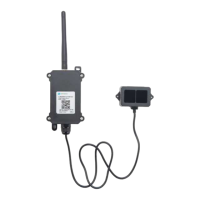
Do you have a question about the Dragino LLDS40 and is the answer not in the manual?
| Model | LLDS40 |
|---|---|
| Category | Accessories |
| Type | LoRaWAN Soil Moisture & Temperature Sensor |
| Communication Protocol | LoRaWAN |
| Humidity Range | 0% to 100% RH |
| Soil Moisture Range | 0% to 100% |
| Soil Moisture Accuracy | ±3% |
| Soil Temperature Accuracy | ±0.5°C |
| Battery | Yes |
| Waterproof Level | IP68 |
| Enclosure Material | ABS |
| IP Rating | IP68 |
| Product Type | Sensor |
| Frequency Band | EU868, US915, AS923, AU915 |
| Temperature Range | -40°C to 85°C |
| Soil Temperature Range | -40°C to +85°C |
| Power Supply | Battery |
| Battery Type | Li-SOCI2 |
| Operating Temperature | -40°C to 85°C |
| Weight | 150g |
| Battery Life | Up to 5 years (depends on usage) |
Describes the Dragino LLDS40 as a LoRaWAN LIDAR ToF Distance Sensor for IoT, its measurement range, and applications.
Lists key features like LoRaWAN 1.0.3 Class A, low power consumption, laser technology, measurement range, and battery life.
Details the probe's operating temperatures, measurement distance, resolution, light immunity, enclosure rating, light source, and FOV.
Provides technical drawings with dimensions for the LiDAR probe unit.
Lists various application scenarios for the LLDS40, including distance measurement, parking management, and robot obstacle avoidance.
Mentions pin mapping and power on procedures, though detailed diagrams are not on this page.
Explains that LLDS40 uses OTAA Class A mode and how it joins a LoRaWAN network with pre-loaded keys.
Provides a step-by-step guide for connecting the LLDS40 to The Things Network (TTN) using OTAA.
Explains how to check the battery voltage from the uplink payload data.
Describes how to interpret the DS18B20 temperature sensor data from the payload.
Explains how to interpret the distance measurement value from the payload, including units and range.
Details the meaning and interpretation of the distance signal strength field in the uplink payload.
Explains the 'Interrupt flag' field and its meaning for uplink packets.
Describes the interpretation of the LiDAR sensor's internal temperature reading from the payload.
Explains the 'Message Type' field in the uplink payload and its possible values.
Guides on setting up payload formatters in TTN to decode the LLDS40's uplink data.
Explains how to change the data uplink interval using AT Command or LoRaWAN Downlink.
Details the steps to integrate TTN with DataCake for visualizing sensor data.
Lists uplink and downlink frequencies and spreading factors for the EU863-870 band.
Explains frequency band usage for USA, Canada, and South America, including sub-band handling.
Describes the frequency band used in China, specifying the default CHE setting.
Details frequency band usage for Australia and New Zealand, including sub-band handling.
Lists uplink and downlink channels for AS920-923 and AS923-925 bands.
Lists default, uplink, and downlink channels for the KR920-923 band.
Lists uplink and downlink channels for the IN865-867 band.
Explains the meaning of the LED indicator on the LLDS40 for different states.
Provides links for firmware download and upgrade method instructions.
Explains the Time of Flight principle, how the LLDS40 emits waves and calculates distance.
Describes the detection angle, spot size at different distances, and the relationship between target size and range.
Warns about factors affecting measurement accuracy, such as reflectivity and transparent objects, and probe cleaning.
Lists various materials and their reflectivity percentages, indicating how they affect readings.
Outlines the categories of commands for general system settings and LoRaWAN protocol.
Details AT commands and downlink payloads to set the data transmit interval.
Explains AT commands and downlink payloads for setting the interrupt mode for GPIO_EXIT.
Describes the downlink command to retrieve firmware version information and the expected uplink response.
Describes the 8500mAH ER26500 Li-SOCl2 battery, its characteristics, and minimum working voltage.
Provides instructions on how to replace the battery, including voltage considerations and component identification.
Offers notes on battery usage, recommending a minimum transmit interval for optimal battery life.
Gives detailed guidance on replacing the battery, including voltage compatibility and component modifications.
Explains how to connect to the LLDS40 using a USB to TTL adapter for AT command configuration.
Provides instructions on how to upgrade firmware to change LoRa frequency bands or region.
Addresses issues where AT commands are not recognized and suggests checking for ENTER key inclusion.
Explains causes of distance errors, like high reflectivity or blocked filters, and their solutions.
Lists part numbers and indicates how the 'XX' denotes the default frequency band.
Details the package contents and dimensions/weight information for the device.
Provides support contact information and operating hours.
